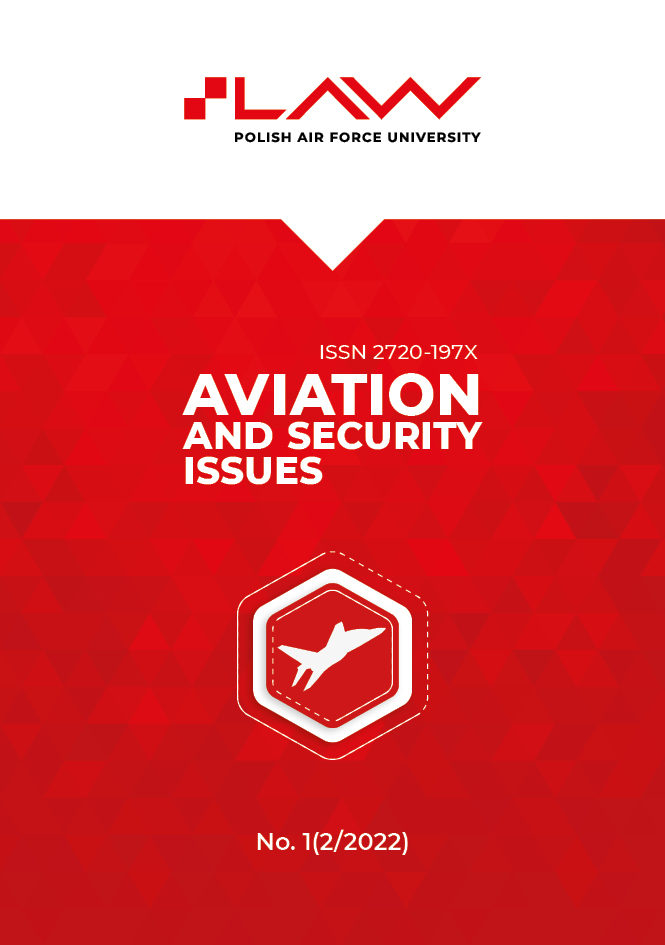EWOLUCJA ZMIAN W PRZECIWDZIAŁANIU ZAGROŻENIOM TERRORYSTYCZNYM W STRATEGIACH BEZPIECZEŃSTWA NARODOWEGO RZECZYPOSPOLITEJ POLSKIEJ
##plugins.themes.bootstrap3.article.main##
Abstrakt
Zagrożenia terrorystyczne stanowią poważny problem związany z zapewnianiem bezpieczeństwa państwowego. Dla ograniczenia mogących się pojawić zagrożeń opracowywane są dokumenty, które następnie tworzą podstawę systemów zapewniających bezpieczeństwo kraju.
W Polsce takim dokumentem jest strategia bezpieczeństwa narodowego Rzeczypospolitej Polskiej. W ostatnich kilkunastu latach strategie bezpieczeństwa narodowego były trzykrotnie zmieniane. W następujących po sobie dokumentach, wyznaczających kierunki kształtowania bezpieczeństwa kraju, podejście do problematyki zagrożeń terrorystycznych nie było traktowane jednakowo. Celem niniejszej publikacji była ocena kolejnych strategii w zakresie podejścia ich twórców do problematyki zagrożeń terrorystycznych na tle zmieniającej się sytuacji politycznej, militarnej, gospodarczej i zdrowotnej wewnątrz kraju i poza jego granicami. Artykuł stanowi opracowanie o charakterze teoretycznym, w którym wnioski zostały sformułowane na podstawie analizy treści kolejnych strategii bezpieczeństwa narodowego, aktów prawnych i literatury opisującej
problematykę zagrożeń terrorystycznych. Za początek analizy wyznaczono datę przystąpienia Polski do strefy Schengen. Związane jest to z przyjętym założeniem, że zniesione kontrole graniczne w państwach członkowskich umożliwiły swobodny przepływ ludności, co mogło stać się czynnikiem sprzyjającym prowadzeniu działalności terrorystycznej.
##plugins.generic.usageStats.downloads##
##plugins.themes.bootstrap3.article.details##

Utwór dostępny jest na licencji Creative Commons Uznanie autorstwa – Użycie niekomercyjne – Bez utworów zależnych 4.0 Międzynarodowe.
Bibliografia
Artykuły i monografie naukowe
Çelik F.B., Foreign policy decision-making in operational overlap: the UK’s policing assistance in Afghanistan through the EU and NATO, „European Security” 2020, nr 4(29), DOI: 10.1080/09662839.2020.1784143.
Dryhurst S., Schneider C.R. i in., Risk perceptions of COVID-19 around the world, „Journal of Risk Research” 2020, nr 23, DOI: 10.1080/13669877.2020.1758193.
Hołyst B., Kryminologia, Warszawa 1986.
Hone T., Terrorism. CIA, and South America. Crescat Scientia, „Journal of History and Political Science” 2017.
Koziej S., Brzozowski S., Strategie bezpieczeństwa narodowego RP 1990–2014. Refleksja na ćwierćwiecze, [w:] Strategia bezpieczeństwa narodowego Rzeczypospolitej Polskiej. Pierwsze 25 lat, red. R. Kupiecki, Wojskowe Centrum Edukacji Obywatelskiej im. płk. dypl. Mariana Porwita, Warszawa 2015.
Kucharek D., Możliwości ograniczania skutków użycia broni masowego rażenia w obiektach wojskowych, w sytuacji narastającego zagrożenia terroryzmem, „Zeszyty Naukowe AON” 2003, nr 1(50)A.
Kupiecki R., Strategia Bezpieczeństwa Narodowego RP 2014 jako instrument polityki państwa. Uwarunkowania zewnętrzne i aspekty procesowe, „Bezpieczeństwo Narodowe” 2015, nr 1.
Lasoń M., Polska strategia bezpieczeństwa narodowego na początku XXI wieku, „Krakowskie Studia Międzynarodowe” 2007, nr 4.
McCann W.S., Pimley N., Mixed Mandates: Issues Concerning Organizational and Statutory Definitions of Terrorism in the United States, „Terrorism and Political Violence” 2018, DOI: 10.1080/09546553.2017.1404457.
Mohtadi H., Murshid A., A Global Chronology of Incidents of Chemical, Biological, Radioactive and Nuclear Attacks: 1950-2005, Grant number N-00014-04-1-0659 supported by the U.S. Department of Homeland Security, 2006.
O’Loughlin J., Toal G., Does War Change Geopolitical Attitudes? A Comparative Analysis
of 2014 Surveys in Southeast Ukraine, „Problems of Post-Communism” 2020, nr 67, DOI: 10.1080/10758216.2019.1672565.
Orłowski P., Strategia Bezpieczeństwa Narodowego Rzeczypospolitej Polskiej 2020, „Analiza KBN” 2020, nr 10(62).
Perliger A., How Democracies Respond to Terrorism: Regime Characteristics, Symbolic Power and Counterterrorism, „Security Studies” 2012, nr 21, DOI: 10.1080/09636412.
706505. Posłuszna E., Ekstremizm ekologiczny, Wydawnictwo Naukowe Scholar, Warszawa 2012.
Wiak K., Przeciwdziałanie aktom terroru i terroryzmowi, [w:] Bezpieczeństwo państwa. Zadanie podstawowe, red. W. Lis, KUL, Lublin 2014.
Akty i dokumenty prawne
„Narodowy Program Antyterrorystyczny na lata 2015–2019”, Załącznik do Uchwały nr 252 Rady Ministrów dnia 9 grudnia 2014 r. (Monitor Polski, poz. 1218).
„Strategia Bezpieczeństwa Narodowego Rzeczypospolitej Polskiej 2007”, BBN, Warszawa 2007.
„Strategia Bezpieczeństwa Narodowego Rzeczypospolitej Polskiej 2014”, BBN, Warszawa 2014.
„Strategia Bezpieczeństwa Narodowego Rzeczypospolitej Polskiej 2020”, BBN, Warszawa 2020.
Ustawa z dnia 10 czerwca 2016 r. o działaniach antyterrorystycznych (Dz.U. z 2016 r., poz. 904).
Źródła internetowe
https://www.prezydent.pl/aktualnosci/wydarzenia/nowa-strategia-bezpieczenstwa- -narodowego-rp-,1752 [dostęp: 7.08.2022].
Strefa Schengen to jeden z filarów integracji europejskiej – Polska przystąpiła do układu 21 grudnia 2007 r.,
https://portalstatystyczny.pl/strefa-schengen-to-jeden- -z-filarow-integracji-europejskiej-polska-przystapila-do-ukladu-21-grudnia-2007-r/ [dostęp: 7.08.2022].

